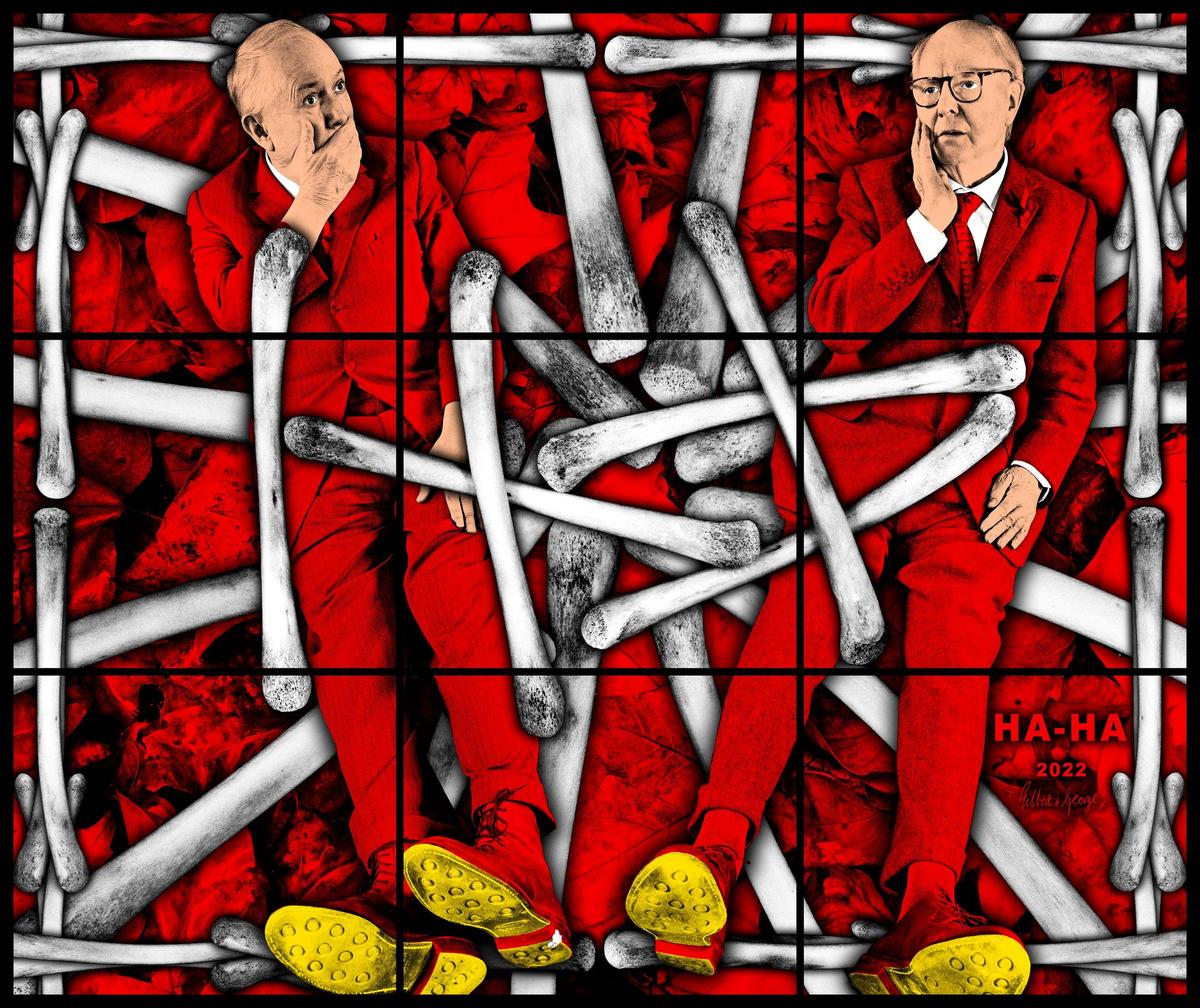A huge new exhibition of Gilbert & George’s work over the last 25 years is opening at Hayward Gallery on the Southbank this week. Called 21st Century Pictures, it brings together the jaw-dropping work of one of the beloved duo in one of the must-see shows of a packed autumn art schedule.
Here, Rachel Thomas, Roden Chief Curator at Hayward Gallery picks out her favourite pieces from the show:
SEX MONEY RACE RELIGION, 2016
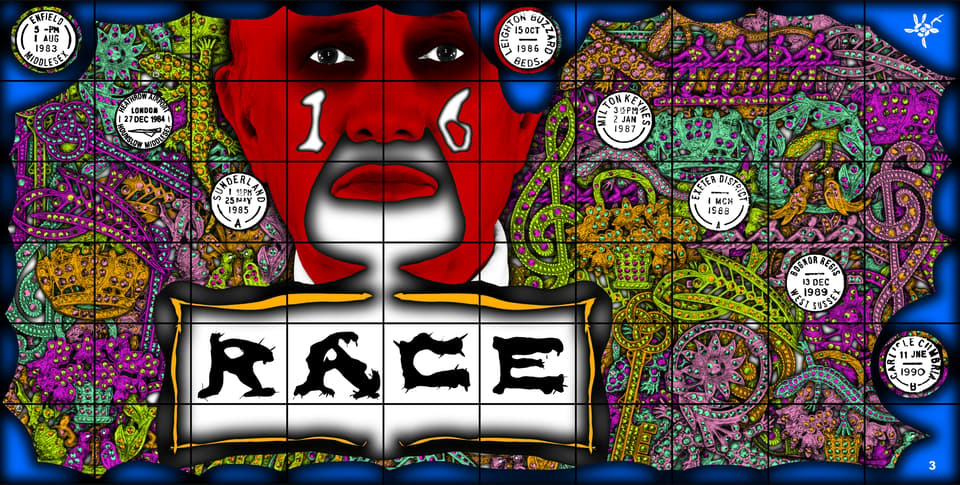
Gilbert & George, SEX MONEY RACE RELIGION, 2016
Courtesy the artists and Foundation Louis Vuitton, Paris.
I love this work, it’s one of my favorites in the exhibition and marks the first time it has been shown in an institution. We see here how Gilbert & George’s pictures draw our attention to humanity. The artists have said ‘Our art is death, hope, life, fear, sex, money, race, religion, shitty, naked, human, world.’ They boldly address major existential topics that many prefer to avoid, confronting us with the emotional and political forces that shape modern life. This four-part picture is a follow up to their 1984 picture ‘DEATH HOPE LIFE FEAR.’
The work is part of a series called THE BEARD PICTURES, in which Gilbert & George appear cartoon-like with heads too big for their tiny bodies. Inspired by a leaf that looked like a beard, they questioned the meaning of beards and what beards represent in different cultures and settings.
THE BEARD PICTURES were first unveiled in a 2017 exhibition celebrating 50 years of Gilbert & George working and living together.
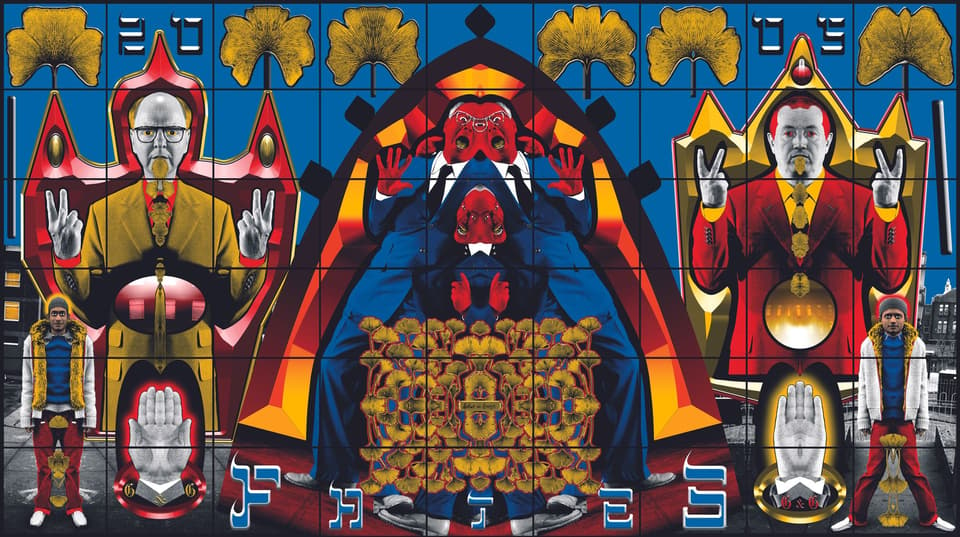
FATES, 2005
Courtesy the artists and Tate_ Purchased with assistance from Tate Members 2006.
A burst of primary colours here, and to me a fun way of seeing double! Gilbert & George first noticed Ginkgo leaves in Gramercy Park during a trip to New York. They collected the leaves and brought them back pressed between the pages of the telephone directory that they took from their hotel room.
Back in London they saw a Ginkgo leaf on the floor and thought it must have slipped out of their bag, but then realised they were surrounded by Ginkgo trees in London – they’d just never noticed before!
The leaves have two symmetrical halves, mirrored in the symmetry of the work, and they symbolise love, friendship, connection and hope.
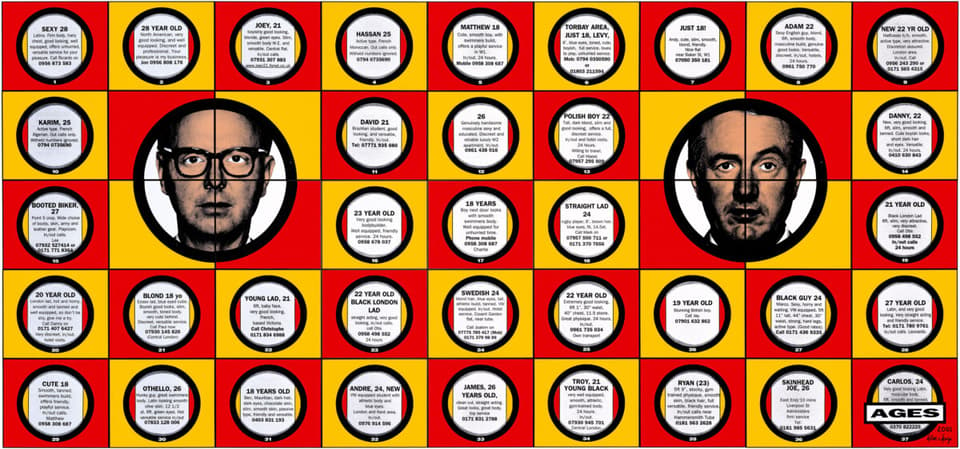
AGES, 2001
Courtesy the artists and Bonnefanten Maastricht.
Gilbert & George spent years collecting escort advertisements from the streets of London, as well as in flyers and newspapers, which they then organised by different classifications. In AGES the ads are sorted by age. The artists stated ‘We have to make these people art because at the moment, they are so overlooked.’
In this series, NEW HORNY PICTURES, the dark, sexual underbelly of the city is unearthed and displayed, with the exposure of the ads reminiscent of gravestones or names on a war memorial.
The oldest work on display in the exhibition, this work was created before the artists embraced digital technology into their making process, combining analogue photographic negatives with hand-dyeing.
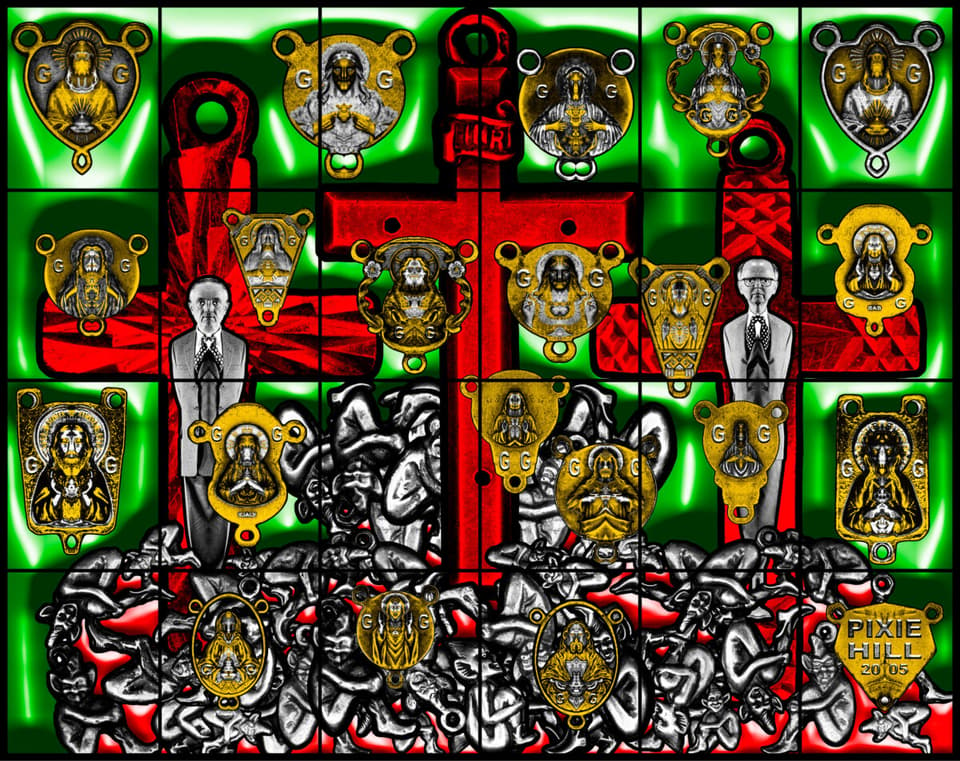
PIXIE HILL, 2005
Courtesy the artists and The David and Indrė Roberts Collection.
PIXIE HILL and the rest of the SONOFAGOD works have dramatic visual impact, taking inspiration from Neo-Gothic Medievalism. The works are regal, lustrous and ornate, looking almost bejewelled.
The imagery is eclectic, with a collision of religious and superstitious symbolism. George was born in Devon, and pixies are said to have lived there and have become emblematic of the region. Carrying a pixie charm is said to be a symbol of good luck.
The merging of sacred symbols of faith and lucky charms collapses the divide between organised religion and superstition. Gilbert & George prompt us to consider how belief systems function.
‘We think every single person is religious to a certain degree.’ Gilbert & George have said. ‘We try to sort out what that means.
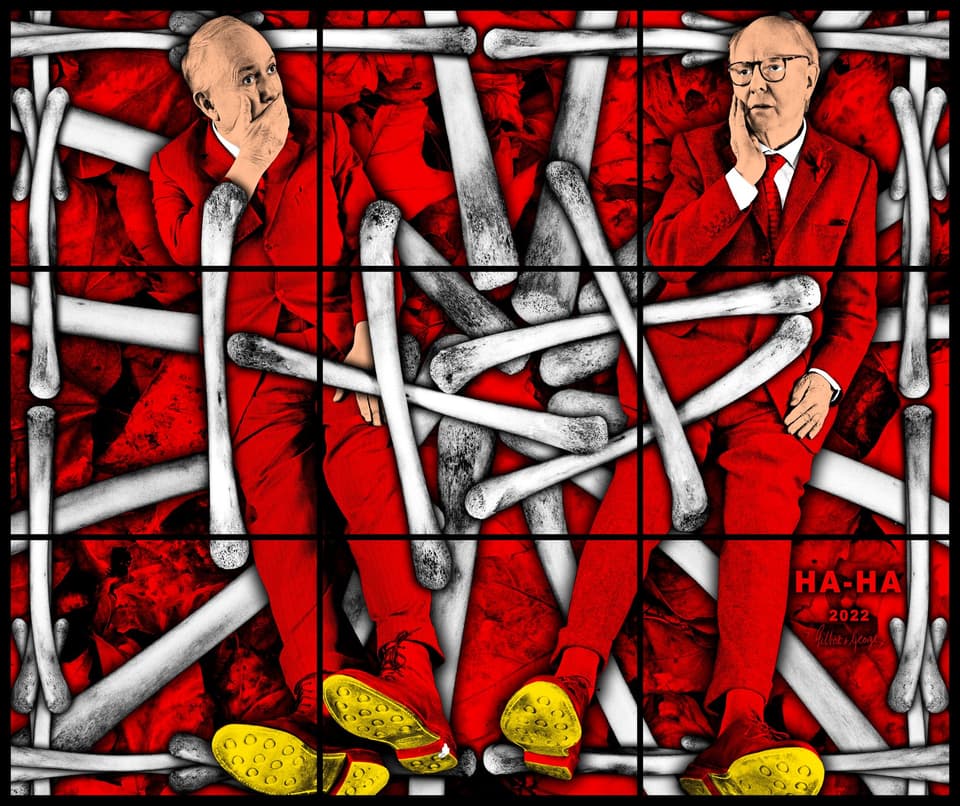
Gilbert & George, HA-HA, 2022
Courtesy the artists and Lehmann Maupin, New York, Seoul, and London.
HA-HA – a work from THE CORPSING PICTURES – has a dark humour and symbolism, confronting mortality head on. The title refers to both dead bodies and the theatrical slang for an actor stepping out of character, revealing the pretence of the theatre. In HA-HA, Gilbert & George are caught somewhere between sleep, death and performance.
Physicality is central to Gilbert & George’s work with their own bodies serving as vessels through which they explore identity, desire, transformation and mortality.
In this surreal and abrupt reckoning with death, the artists lie among bones, the soles of their shoes revealed and gold, referencing Dick Whittington who said the streets of London were paved with gold.
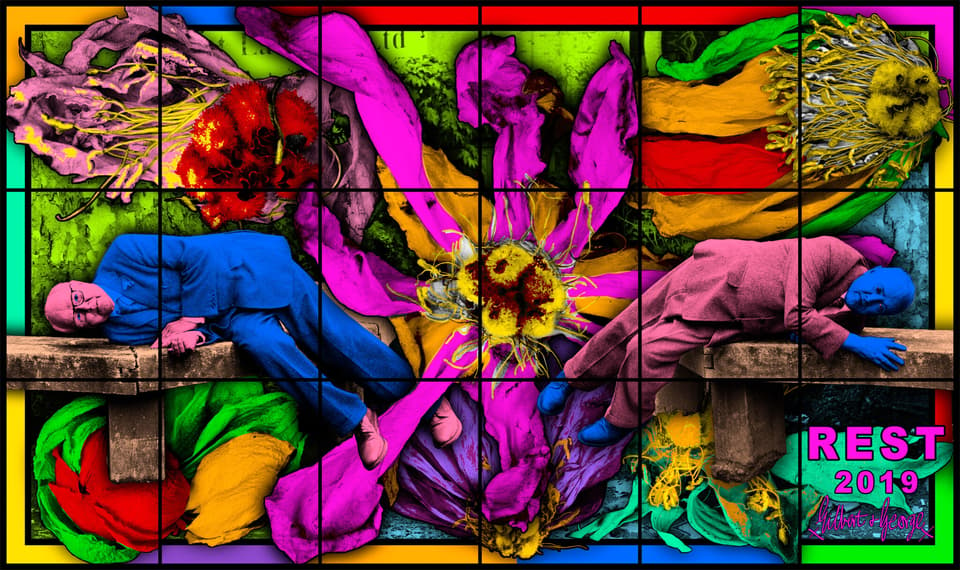
REST, 2019
Courtesy the artists and Foundation Louis Vuitton, Paris
REST is among a selection of works from THE PARADISICAL PICTURES portraying a fantastical, hallucinatory and psychedelic vision of paradise.
Gilbert & George wander through this brightly coloured afterlife, filled with fruits, flowers, leaves and trees, merging into the plant kingdom. There is a common motif of blossoming in nature – usually a joyful event, but on closer inspection the flowers are fading, the fruits are dried, and Gilbert & George exude exhaustion, lying awkwardly across a bench.
The artists confront their own transience and the process of aging, reflecting on cycles of passing and reawakening, life and death.
.jpeg)
Gilbert & George, TWIG, 2024
Courtesy of Gilbert & George
SCREW PICTURES is a new, never before seen body of work, in which the artists surround themselves with simple, everyday objects such as screws, nuts, bolts and twigs. Their work increasingly confronts their own mortality, and in this series, the artists turn their attention inward, drawing on materials collected from their immediate surroundings in their home and the nearby streets. A sense of introspection permeates these pictures, elevating the mundane.
In TWIG, the artists position themselves on either side of the composition, flanked by the austere symbolism of a branch. When asked about the meaning, George replied ‘We are all twigs on a very, very large tree – we are all connected.’
TWENTY-EIGHT STREETS, 2003
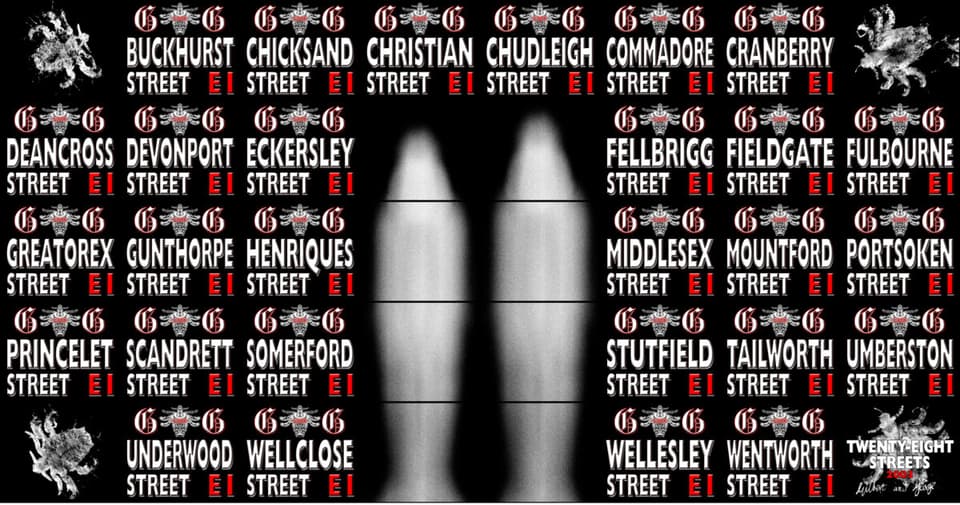
Gilbert & George, TWENTY-EIGHT STREETS, 2003
Courtesy the artists and Collection Mudam Luxembourg – Musée d’Art Moderne Grand-Duc Jean.
In TWENTY-EIGHT STREETS Gilbert & George alphabetically list the names of streets in East London, where they have lived and worked since the 1960s. Just off Brick Lane, the area is a melting pot of cultures, filled with both artistic aspirational creativity and acute poverty.
Gilbert & George appear as two digitally manipulated silhouettes, seemingly dissolving into the background, resembling ghostly astral bodies.
